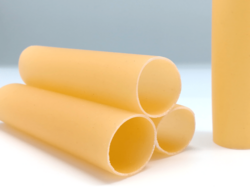Cannelloni facts for kids

Uncooked manicotti-style extruded cannelloni
|
|
| Alternative names | cannaciotti, manfriguli/manfrigoli (Valtellina), canneroni/cannaroni (Naples), cannoli, crusetti (Sicily), canelons (Catalonia) |
|---|---|
| Type | lasagna |
| Course | main (primo piatto) |
| Place of origin | Italy |
| Serving temperature | baked warm to hot |
| Main ingredients | wheat flour (durum), water |
| Variations | manicotti |
Cannelloni (pronounced "kan-nel-LOH-nee") is a type of lasagna pasta shaped like large tubes. The name means "large reeds" in Italian. This pasta is usually served baked with a tasty filling inside. It is then covered with a delicious sauce.
In Italian cuisine, popular fillings for cannelloni include spinach mixed with ricotta cheese. Another common filling is minced beef. After being filled, the pasta tubes are typically covered with a rich tomato sauce.
Cannelloni is also a traditional dish in Catalan cuisine, found in a region of Spain. There, it is called canelons. People in Catalonia often eat canelons on Saint Stephen's Day, which is celebrated on December 26th.
The History of Cannelloni
People have been making stuffed pasta for a long time. Early mentions of "stuffed macaroni" can be found as far back as 1770. However, the specific word "cannelloni" for this tube-shaped pasta seems to have become popular around the start of the 1900s.
Cannelloni vs. Manicotti
You might have heard of Manicotti. This is the American version of cannelloni. Sometimes, the word "manicotti" can even refer to the whole baked dish itself.
Originally, there was a small difference between the two. Cannelloni was often made by wrapping flat sheets of pasta around the filling. Manicotti, on the other hand, was usually made using a machine that pushed out (or "extruded") the pasta into hollow tubes. These tubes were then filled from one end. Today, both terms might be used to describe similar baked pasta dishes.
See also
- In Spanish: Canelones (comida) para niños

